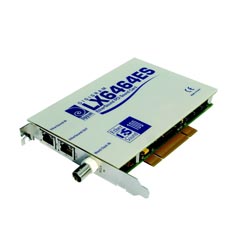- Digigram's LX6464ES soundcard, with its ethernet in and out connectors, exemplifies the way computer based audio applications can be linked to an EtherSound network. The following is the second in a series of Protocol Primers. This month we tackle EtherSound, providing a technical overview as to the capabilities of an EtherSound network, and some considerations when setting up such a network. In subsequent issues, we will provide a technical overview of Audinate's Dante, Aviom's A-Net, and others.
- In 2001 a uni-directional low-latency transport called "EtherSpeaker" debuted at IBC (Amsterdam) and AES (New York) from the French company Digigram. By 2002 it had been renamed EtherSound, and early 2003 saw the release of products from various EtherSound licensees. A year later the transport became bi-directional and the number of licensees and related products continued to grow. 2006 marked the release of ES 100, which supported redundant ring topologies and extended control capabilities.
- Its very low latency, coupled with flexible topology, has made it popular, especially in live and touring sound applications, as well as fixed installs.
- The Lingo
- In/Out Device Connections
- -All EtherSound devices have two RJ-45 connectors-in and out
- -Daisy-chain "out" of one device to the "in" of the next
- -In star topologies, a unique device will send its stream from its out port to an ethernet switch which will then distribute the stream to the in ports of the other devices
- Master/Slave
- -One master per network
- -Master is the clock master
- -With ES-100, control can be inserted from any point in the network
- -Slaves are devices on the network, slaved to the clock of the master
- Loopback Node
- -Device at the end of daisy-chain topology for bi-directional audio
- -Loops downstream back upstream towards the master
- Upstream/Downstream
- -Network audio flow convention relative to the master
- -Audio channels flowing from the master towards the slaves are downstream
- -Audio channels flowing to the master from slaves are upstream
- Parameters
- -Latency: 125 uS + 1.4 uS per node
- -Bitwidth: 24 bits
- -Sample rate: 48 kHz (standard), 96 kHz available
Consideration For Your System
When installing an EtherSound the primary thing to consider is the system topology:
Daisy-Chain
-Majority of EtherSound applications/installations
-Provides bi-directional audio transfer via loop back node
-Ease of connection, device to device (Device A Out to Device B In...)
Ring
-A closed loop daisy-chain
-Provides redundant audio path
